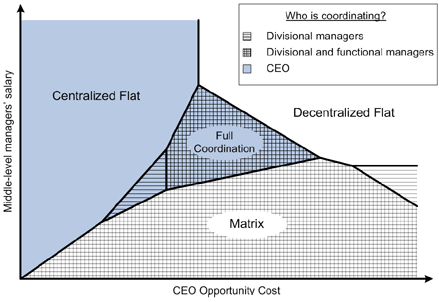Finance & Accounting Strategy Leadership Economics Feb 1, 2008
When Should a Firm Decentralize?
Corporate features can determine your organization’s design
Ask a nanoscientist how an amazing new molecule was built and you’re liable to hear, “It assembled itself.” Observations of such self-organizing systems are increasingly common in the natural sciences, as complex structures and astounding properties emerge without any influence from external sources. In the corporate arena, however, a boardroom decision to let a company “assemble itself” would probably lead to panic on the trading floor. When it comes to corporate structuring, it is far more normal for the players to engage in some intelligent design, to co-opt the phrase. In this vein, Kellogg School of Management Professor Artur Raviv (Finance) and longtime collaborator Milton Harris (formerly of Kellogg, now at the University of Chicago) write in Management Science about how various features of corporations can determine the structures by which the company should be organized.
“Overall, my research was in the areas of uncertainty and asymmetric information, incentives, and decision-making,” said Raviv, the Alan E. Peterson Distinguished Professor of Finance. “This research came along with the question of capital budgeting. How are budgets determined in a corporation? Are they determined locally or at an upper level? Who decides what? Does everything go to the top, to the CEO?”
Modern organizations typically organize according to four commonly observed structures: flat, divisional hierarchy, functional hierarchy, and matrix. To illustrate these structures, consider a simple company that produces and sells two different versions of a product, like chocolate and vanilla ice cream, 220 volt and 110 volt hairdryers, or English and Spanish versions of a magazine. Though essentially the same, each version of the product must incorporate unique design features, and each must be pitched differently to its own unique market. How should these four basic tasks, design and marketing for two versions of a product, be organized?
In a flat structure, the managers in charge of each project—for example, chocolate design, chocolate marketing, vanilla design, and vanilla marketing—report directly to the CEO without having to go through any intermediaries. In some cases, this flat, minimal structure is reduced even further, decentralized, with each project manager free to act without reporting to the CEO. In such structures, there is little perceived benefit to extensive coordination of multiple projects, so project managers are entrusted with freedom to lead their specific areas as they see fit.
In a divisional hierarchy, two midlevel managers are introduced between the project managers and the CEO, each charged with coordinating all aspects of a certain product or region. One midlevel manager coordinates chocolate design and marketing, for example, while the other leads design and marketing for vanilla. This structure offers benefits that are possible only by integrating the many functions required to create and sell a product. For example, greater awareness of market trends (“People really like chocolate!”) may improve product design (“Make the chocolate more chocolatey!”).
A functional hierarchy also has two middle managers, each responsible for coordinating certain tasks that are common across all products or regions. For example, one manager would focus on design for both chocolate and vanilla, while the other would lead marketing efforts for both flavors. While sacrificing some of the benefits of project integration enjoyed in the divisional hierarchy, the functional structure offers the advantage of economies of scale. For example, design of all products might be handled most efficiently by a central design office that is able to take advantage of knowledge, skills, and resources that are translatable across both versions.
Seeking to capitalize on the benefits of both divisional and functional hierarchies, the matrix structure introduces four middle managers, with each project manager reporting to two different midlevel managers. For example, the unit responsible for chocolate design reports to a design manager, who also oversees vanilla design, and to a chocolate manager, who also oversees chocolate marketing.
Harris and Raviv sought to understand and model key features of companies that determine which organizational structures would be most beneficial under which conditions. Said Raviv, “This is fundamental research. It’s difficult to understand. But can I at least understand some trends?”
In the Harris and Raviv model, as in the simple ice cream company described above, the most basic activities are led by project managers, whose expertise and influence are confined to their specific projects. So the vanilla design manager knows only vanilla design. Only someone with a broader perspective, above the level of narrowly focused project managers, could appreciate and coordinate multiple projects in a way that might benefit the company. It is at this level, for this reason, that midlevel managers are put to work.
But a midlevel manager’s ability to coordinate is limited to interactions within her specific division or function. The design manager could coordinate chocolate design with vanilla design, but if there is some benefit to be gained from integrating chocolate design with vanilla marketing, only someone with a company-wide perspective could coordinate those projects. That “someone” is the CEO.
CEOs, if nothing else, are busy. They can’t spend all their time coordinating interactions among projects. They have strategies to plan, relationships to cultivate. So while time spent by project managers and midlevel managers on nurturing and coordinating projects is time spent doing exactly what they’re paid to do, time spent by a CEO on such coordination is time taken away from other important business. In the standard language of business, those potential benefits that are forfeited because a CEO must instead coordinate projects are referred to as the opportunity cost. So in addition to enhancing a company’s value by coordinating projects to improve products, midlevel managers also benefit companies by shielding their CEOs from having to spend too much of their valuable time on project integration.
The model that Harris and Raviv developed brings all of these features into play, pitting the benefits of project integration against the costs of coordinating those interactions. Specifically, the model incorporates probabilities that beneficial interactions might occur between projects within the same division or functional area (e.g., between chocolate design and vanilla design). But such benefits don’t simply happen for free, so the model must also consider the amount of salary required to hire midlevel managers to recognize and coordinate those interactions. The model incorporates the benefit that might be gained from company-wide interactions spanning multiple divisions or functional areas (e.g., between chocolate design and vanilla marketing). Since only CEOs are in the position to coordinate such company-wide interactions, the model also considers the opportunity cost incurred when the CEO coordinates those interactions instead of doing something else with her time.
“We started with a very simple structure, thinking it couldn’t be any easier,” said Raviv. “But to derive the results, it was like pulling teeth. That proved to be difficult. The analytical portion is big, a lot of inequalities.”
The patterns described by those inequalities allowed Harris and Raviv to illustrate some notable features of organizational structures. In Figure 1, for a typical case like our ice cream example, Harris and Raviv were able to represent the optimal organization design for any combination of CEO opportunity cost and the salary level of middle managers. Each region depends, in turn, on the synergy gains of integrating company-wide interaction and the probabilities of interactions within product lines and within functions.

Figure 1: Optimal Organization Design for a Typical Case
For example, as the size of a company increases, the demands on the CEO’s time and effort increase; thus, the CEO’s time becomes more valuable. Given this relationship between company size and the CEO’s opportunity cost, this model can predict structural changes that are likely to occur across the life cycle of a growing company. Young, small firms are likely to have a centralized, flat structure, with project managers reporting directly to CEOs who are highly involved in project coordination. CEO involvement in such coordination will decrease, and the structure will become more decentralized, as companies grow.
If the cost of hiring middle managers is high, firms will then grow directly to a flat, decentralized structure, with little CEO involvement in coordinating projects. But if middle managers are inexpensive, the firm will evolve to a matrix organization, ripe with middle manager coordination, before slimming down to a decentralized hierarchy, employing only the managers necessary to exploit the most likely interactions. If middle managers are neither prohibitively expensive nor fantastically affordable, then the company will adopt a centralized hierarchy before evolving according to the patterns described above for cheap or pricey management.
“This work is still immature. You couldn’t hire me as a consultant to say, ‘Do this to your company,’” said Raviv. However, he then added, with enthusiasm, “Maybe it will show up in textbooks in 20 years. But even though I couldn’t go in and teach this to the MBA class right now, it would certainly inform me about the issues that I teach.”
In addition to patterns of growing companies, the model allows prediction of business conditions in which the benefits to be gained from CEO coordination of company-wide interactions are most pronounced. For example, firms are more likely to be highly centralized, with relatively frequent CEO involvement in coordination, if they are in highly unstable environments, if they are in relatively unregulated sectors, if they don’t reward managers based on company-wide performance, or if they face particularly constrained resources.
One aspect of this model that Raviv clearly recognizes as needing more work involves the role of incentives among management. He said, “If you were to introduce incentives, then clearly you have a more complicated model in which a manager has information but might communicate it or use it differently depending on his motivations. For example, does he have plans for empire building?”
While recognizing that the issue of incentives hasn’t been completely cleared up, Raviv was excited about other directions in which this work has been heading (Harris and Raviv, 2005, 2007, 2008).
“We continued in this mode, but we didn’t talk about the general structure. We moved on to the board of directors and their interaction with managers,” said Raviv. “And then we looked at how the board and managers interact with shareholders. This gets to the question of shareholder democracy, which is very popular now. Should shareholders be allowed to pick board members? The SEC will decide upon that.”
Regardless of what the SEC decides, this work can provide a template to suggest what kind of business arrangements are most appropriate for which conditions. As Raviv pointed out, “This work is all in the mode of designing contractual arrangements between parties.” Assuming that contractual arrangements aren’t disappearing from business anytime soon, this line of research can only enhance our best efforts to better design.
Further reading:
Harris, Milton and Artur Raviv (2005). “Allocation of Decision-Making Authority,” Review of Finance, 9(3): 353-383.
Harris, Milton and Artur Raviv (2007). “A Theory of Board Control and Size,” Review of Financial Studies, forthcoming.
Harris, Milton and Artur Raviv (2008). “Control of Corporate Decision: Shareholders versus Management,” Working Paper, January.
Harris, Milton and Artur Raviv (2002). “Organization Design,” Management Science, 48(7): 852-865.


